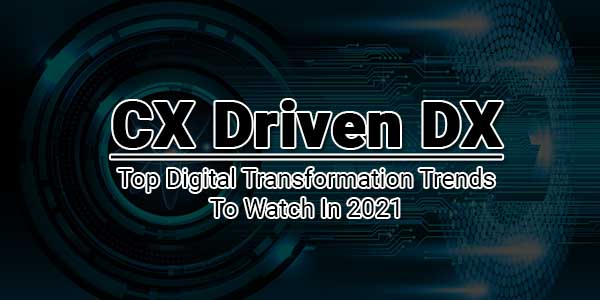
Digital Transformation Trends – Every Global Economic Crisis is followed by path-breaking Digital Conditioning of all industrial sectors. The Global Financial Crisis 2008 gave birth to the revolutionary RegTech (Regulatory Technology) and Fintech (Financial Technology) culture for the BFSI (Banking, Financial Services & Insurance) sector. Similarly, the ‘Early 2000s recession’ gave rise to e-commerce (Amazon, eBay, etc.) and digital payments (PayPal, Yandex, WebMoney, etc.) scenario.
This time the ongoing Coronavirus Crisis has changed the industry in terms of unsolicited digital transformation across various sub-domains. From the change in retail business behavior on account of contactless interactions and direct to customer services (telehealth, remote banking, etc.); the world is heading towards a different reality. As the consumer behavior of Digital, Natives continues to control the industry outlook, and Digital Immigrants find it easier to adapt, we take a look at the top 3 digital transformation trends that are here to stay in 2021.
Table of Contents
Usage-Based Billing Experiences – Millennials Want Transactional Control:
Millennials have found a way to control their experiences during the COVID-19 pandemic. Powered by flexible payment solutions and inspired by financial relaxations from global governments, consumer behavior has come to demand a usage-based billing experience.
Reports suggest that customers want their billing communications technologies to account for usage-based premiums, peak, and happy hour pricing, outage communications, and more.
Bain & Company 2020 Customer Loyalty Insurance Survey reports that close to 21% of customers have already purchased usage-based insurance. Another 64% are interested in auto insurance premiums tied to safe driving practices (Accenture 2019 Global FS Consumer Study). C&I utility providers (58%) are also rooting for Power Companies that offer transparent reporting for ‘time of use’ tariffs to benefit from 24×7 production at off-peak rates.
In 2021, Service Providers and Distributors might need to integrate various Meter to Cash SaaS Solutions and Integrated Billing Communications platforms to deliver interactive billing experiences to their customers.
Voice Assistants For Core Customer Communications – Now Driving Global Sales:
Usage patterns of voice assistants were mutating daily across demographic domains during peak COVID months (May to August 2020). Banking Applications connected with AI and ML-based voice recognition APIs finally broke the resistance point of consumer adoption. In the last 4 months, usage of voice assistants and devices for product purchase or research has gone up from 32% in 2019 to 57% in 2020 (Salesforce State of Connected Customer Report 2020).
However, an adaptation of customer communications to synchronize with voice assistants remains a challenge for many organizations. Agent Scripting and Conditional Customer Journey Orchestration remain critical needs of conventional service touchpoints.
Voice-based Communications have led to faster checkout, hyper-personalization of customer communications, and agentless self-service experiences and unless 110 million new users (CISCO CX 2020 Report) have to comment otherwise; this digital transformation trend is here to stay.
Mobile First And Omni Channel Communications – Experience Matters!
Half of the Credit Union members in the USA and one-thirds of utility customers were unhappy with service experiences during the COVID-19 pandemic (Bain & Company, 2020).
Prominent reasons for lower customer satisfaction during the pandemic were complex web interfaces, slow experiences, incomplete service resolutions, lack of clarity in bills, and repetitive onboarding steps (American Customer Satisfaction Index, 2020). The key takeaway here is that digital experiences are not going to be enough. Customer Journeys have to be device agnostic, hyper-personalized, and contextual to sync with new behavioral shifts.
As nearly two-thirds (64%) of customers use multiple devices to start and complete transactions (Salesforce, 2020), ‘Mobility’ in customer experiences’ to ensure ‘Choice of Platform’ is rapidly becoming a key performance indicator for organizations.
Also, automated underwriting technologies were found to decrease cycle time for life insurance customers by 18 days (Accenture Automated Underwriting Study 2020). Powered by Omni Channel Communications Platforms another set of fintech institutions achieved a rise of 14% in mean sales volume with AI and CCM based automation.
Integrated Communications Hub with mobile-first communications and development model can lend the much required 360-degree visibility to customer actions and that’s the third Digital Transformation Trend of 2021.
Need Of New Innovators And Early Adopters In Digital Transformation:
The cost of not transforming on the cues of customer experiences is too high to bear. Last year customer switching costs incurred a total loss estimated at USD 1.6 trillion worldwide (Cisco CX 2020 Report). Customers have moved away from branches for a while but they haven’t abandoned the personal experiences they used to have. If anything, it’s evidence that digital transformation in 2021 is going to be customer experience-driven and not productivity-efficiency-inspired. The world might need yet another league of innovators and early age adopters to navigate this economic crisis and make sure that customers find their way back to Normal.

 About the Author:
About the Author:
















Awesome post, thanks for sharing this post with us…
Welcome here and thanks for reading our article and sharing your view. This will be very helpful to us to let us motivate to provide you more awesome and valuable content from a different mind. Thanks again.